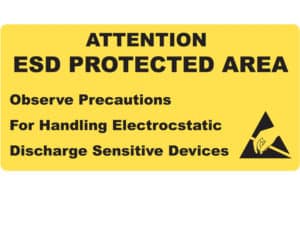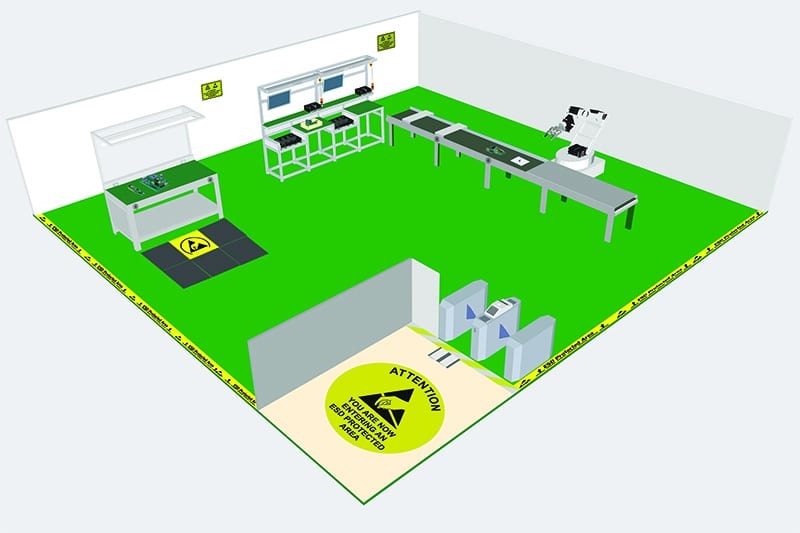When setting up an Electrostatic Protected Area (EPA), it can be quite overwhelming to know what equipment is required and which products you should select. This blog post will help guide you with the following topics:
An Electrostatic Protected Area, also known as an EPA, is a designated area where static is controlled under strict regulations. A static safe handling area could be a bench, a room or any other designated area and should not have any ‘static field’ greater than 100v maximum. Within this designated area, all surfaces, objects, people and ESD Sensitive Devices (ESDs) are kept at the same electrical potential. All surfaces, products and people are bonded to Ground. Bonding means linking, usually through a resistance of between 1 and 10 meg ohms.
An EPA can be a small workstation or a large manufacturing area. These areas enable a safe environment for both operators and static-sensitive devices or components such as PCB boards that are prone to ESD damage. Equipment or products used within an EPA should qualify and comply to the IEC-61340-1-5 International Standard to ensure a safe, static-controlled environment. Everything that does not readily dissipate charge must be excluded from the EPA.
The user guide CLC/TR 61340-5-2:2008 defines an EPA as follows: “An ESD protected area (EPA) is an area that is equipped with the ESD control items required to minimize the chance of damaging ESD sensitive devices. In the broad sense, a protected area is capable of controlling static electricity on all items that enter that work area. Personnel and other conductive or dissipative items shall be electrically bonded together and connected to ground (or a common connection point when a ground is not available) to equalize electrical potential among the items. The size of an EPA can vary greatly. A protected area may be a permanent workstation within a room or an entire factory floor encompassing thousands of workstations. A protected area may also be a portable worksurface or mat used in a field service situation.” [CLC/TR 61340-5-2:2008 Use guide clause 4.6 Protected areas (EPA)].
Electrostatic Discharge (ESD) can damage components and products containing electronics. It is the hidden enemy in many high-tech factories. Often this damage cannot be detected by quality control inspections which can be very frustrating. ESD damage can adversely impact productivity, quality, product reliability and thus a company’s reputation and profitability. An EPA is an area that has been established to effectively control ESD and its purpose is therefore to avoid all problems resulting from ESD damage. Operators need to understand and follow the basics of ESD control to limit the generation of electrostatic charges, limit and slow discharges in the EPA.
In order for you to control electrostatic discharge (ESD) in your workplace, you should follow the three ESD fundamentals listed below.
1) Ground all conductors including people.
2) Remove all unnecessary non-conductors (also known as insulators).
3) Place ESD sensitive devices inside of shielding packaging when transported outside of an ESD Protected Area (EPA).
Per ESD Handbook ESD TR20.20-2008 section 2.4 “It should be understood that any object, item, material or person could be a source of static electricity in the work environment. Removal of unnecessary nonconductors, replacing nonconductive materials with dissipative or conductive materials and grounding all conductors are the principle methods of controlling static electricity in the workplace, regardless of the activity.”
An EPA needs to be identified as such. You can use products such as floor marking tape and/or signs which are designed to attract attention and deliver a clear message to personnel and visitors, i.e. “You are entering an ESD Protected Area” or “You are leaving an ESD Protected Area”. This ensures operators and visitors are alerted when entering (or leaving) an ESD Protected Area which require special precautions (grounding via wrist straps and/or foot grounders etc.). It also indicates that they are entering (or exiting) areas where exposed ESDS items can be handled safely. Remember to be consistent throughout your workplace floor, i.e. use the same signs. This will avoid confusion for your operators.
EPA identifiers include:
Please Note: Floor marking tape and signs are not antistatic as they are intended for use outside the EPA.

A Common Ground Point – An Earth Bonding Point (EBP) Plug or Bracket.
The first step in ensuring that everything in an EPA (ESD Protected Area) is at the same electrical potential is to ground all conductive components of the work area (work-surfaces, people, equipment, etc.) to the same electrical ground point. This point is called the common point ground. The next step in completing the ground circuit is to connect the common point ground to the equipment ground (third wire, green). Most locate the common point ground at the side edge of the workbench or towards the back of the bench-top.
ESD workbenches are suitable for static controlled areas and have worktops which are grounded for the safe discharge of static electricity. If the application involves the use of electrical components, then an anti-static workbench is an essential piece of equipment to help limit damage caused to these components during the work process.
There are two types of workbenches that you can use for your electrostatic protected area (EPA). These types include ESD protective workbenches and regular workbenches. Selecting an ESD protective workbench would be best practice. However, most companies will use a regular workbench. Materials used can vary, but it is best to use a workbench that is constructed of metal and wood, and not one containing large portions of high-charging insulative plastic.
Two types of worktops that you should consider are:
Neostat worktop – has a dual-layer surface covering made from rubber. It has a dissipative top layer and a conductive bottom layer, it is this that creates a safe path to ground. Surface resistivity of Neostat is 105 – 107 ohms.
Lamstat worktop – has a plastic laminate static dissipative surface. This surface is also suitable for work involving soldering, heat and chemicals. Surface resistivity of the Lamstat is of 106 – 108 ohms.
ESD working surfaces, such as mats, are typically an integral part of the ESD workstation, particularly in areas where hand assembly occurs. Most workstations will use pliable ESD matting to cover the bench and be the ESD work-surface on which to handle ESD sensitive (ESDS) items. The mat needs to be grounded and best practice is to use metal grounding hardware snaps and ground cords connecting the work-surface mat to the common point ground. The entire bench-top should be covered by the ESD mat. Matting can be conductive or dissipative.
Walking alone can create static electricity. However, ESD matting can help to disperse this electricity. These mats have electrically conductive carbon fibres throughout. Consequently, the ESD flows at a slower rate across the surface of the mat which in turn neutralises it. There is also matting available which is appropriate to use on workbenches, trolleys and other surfaces.
A Working Surface Mat Grounding Cord and/or a Floor Mat Grounding Cord.
A basic ESD control rule is to ground all conductors including people at the ESD workstation. Grounding works great and will reliably remove ElectroStatic Charges to ground. Find out why you should ‘earth’ yourself by clicking here.
Sometime an ESD workbench is not enough to prevent an ESD event. Therefore, numerous accessories have been developed to help assist in preventing and ESD event. Wrist straps are the first line of defense against ESD, the most common personnel grounding device used, and are required to be used if the operator is sitting. Wrist straps help to disperse static electricity generated from a person. The wristband should be worn snug to the skin with its coil cord connected to a common point ground which is connected to ground, preferably equipment ground. Are wrist straps necessary if all other ESD precautions are taken? Click here to find out.
A Flooring / Footwear system is an alternative for personnel grounding for standing or mobile workers. It is not required to have ESD flooring, but it could be selected to be low charging and/or a means to ground mobile equipment. Per S20.20, the required limit for Flooring is less than 1 x 10E9 ohms. For a stand-alone ESD workstation, a floor mat can be used with a ground cord connected to the workstation’s common point ground. We recommend conductive floor matting less than 1 x 10E6 ohms to be able to meet the Flooring/Footwear required limit of less than 3.5 x 10E7 ohms. Find out when you should consider using ESD flooring by clicking here.
Click here to view our ESD Floor Maintenance.
ESD Foot Grounders (or ESD Shoes)
Instead of a wrist strap, a standing or mobile worker can be grounded using a Flooring/Footwear System. When using an ESD floor, you must consider using ESD Conforming Shoes or, as an alternative, ESD Heel Grounders to ensure that there is a path to ground from the operator via the ESD Heel Strap/ESD Shoe to the floor.
The ESD Heel Strap has one section stuck inside the wearers shoe in contact via their skin or sock and a section loops around the heel of the footwear. ESD footwear or heel grounders are to be on both feet, click here to find out why.
A bench-top ionizer or overhead ionizer can be selected to neutralise ElectroStatic charges at the workstation. This is the only ESD control method available to neutralise ElectroStatic charges on essential insulators or isolated conductors that may be at the workstation. The required limit per S20.20 is less than +/- 50 volts offset voltage (balance). In addition, the Discharge Times should be measured, both the time necessary to reduce +1,000 volts to +100 volts, and the time necessary to reduce -1,000 volts to -100 volts.
Click here to view our 4-Fan Overhead Ionizers. Click here to view our Bench Top Ionizers.
ESD Bags, ESD Packaging and ESD Storage.
Packaging and material handling containers at the ESD workstation should be low charging and have resistance (conductive or dissipative) so ElectroStatic charges can be removed to ground. Shielding bags are also used additionally having the ESD control property of discharge shielding. Pink anti-static bags are ideal for use in transporting non-static sensitive devices, (e.g. nuts, bolts etc.) into an Electro-static Protected Area. (E.P.A.).
Antistatic storage and handling products have high technical bespoke material composition to lower the resistance so that when grounded, electrostatic charges will be removed to ground thus protecting your ESD sensitive devices inside. Click here to view our best-selling euro stacking containers.
ESD Garments and Anti Static Gloves
For very sensitive EPAs you may require employees to wear anti-static clothing and gloves. Antistatic clothing and gloves are an essential part of many electronic manufacturing and engineering companies, including labs, health environments, precision engineering environments. These products can help prevent damage to sensitive electronic components that are being assembled or packaged within a protected area.
Such items may include:

A basic form of an ESD Protected Area is a workstation consisting of the following components:
To set-up an EPA:
1) Connect the ESD working surface mat to the common point ground using the grounding cord.
2) Link the operator to the common point ground using the wristband and coiled cord.
By following the above steps, each component (the ESD mat and the operator) is kept at the same electrical potential (ground). Any ElectroStatic charge (ESD) is removed to ground via the common point ground.
If you would like some more guidance on setting up your Electrostatic Protected Area (EPA), please don’t hesitate to get in touch us on (+44) 01793 511000, sales@bondline.co.uk or fill in the form below. If you’re looking to set up a new ESD area, we recommend an ESD audit. With an ESD audit, we can help you identify what types of ESD products or equipment are needed in order to meet the requirements of the IEC-61340-1-5 and offer solutions on how you can optimise your EPA.
Fields marked with an * are required
On selected products if ordered before 1pm
Dedicated account manager to help your ordering process
Great value on premium quality products
Bondline Electronics Ltd are a leading manufacturer and supplier of static control products within the ESD industry. Products such as Flexible and Rigid Packaging, Bench Matting, Wrist Straps, Heel Grounders and Shoes, ESD Protective Clothing and Gloves, Test and Measurement Equipment along with many storage and handling solutions.
Bondline products are all qualified and compliant according to IEC-61340-5-1 International Standard.
Registered Company Number: 02933918
Office Hours: Mon – Thurs: 9am – 5pm Fri: 9am – 2pm

Bondline Electronics Ltd are a leading manufacturer and supplier of static control products within the ESD industry. Products such as Flexible and Rigid Packaging, Bench Matting, Wrist Straps, Heel Grounders and Shoes, ESD Protective Clothing and Gloves, Test and Measurement Equipment along with many storage and handling solutions.
Some of these cookies are essential, while others help us to improve your experience by providing insights into how the site is being used.
For more information and to read more about our privacy policy, please visit our Privacy Policy
Necessary cookies enable core functionality. The website cannot function properly without these cookies, and can only be disabled by changing your browser preferences.